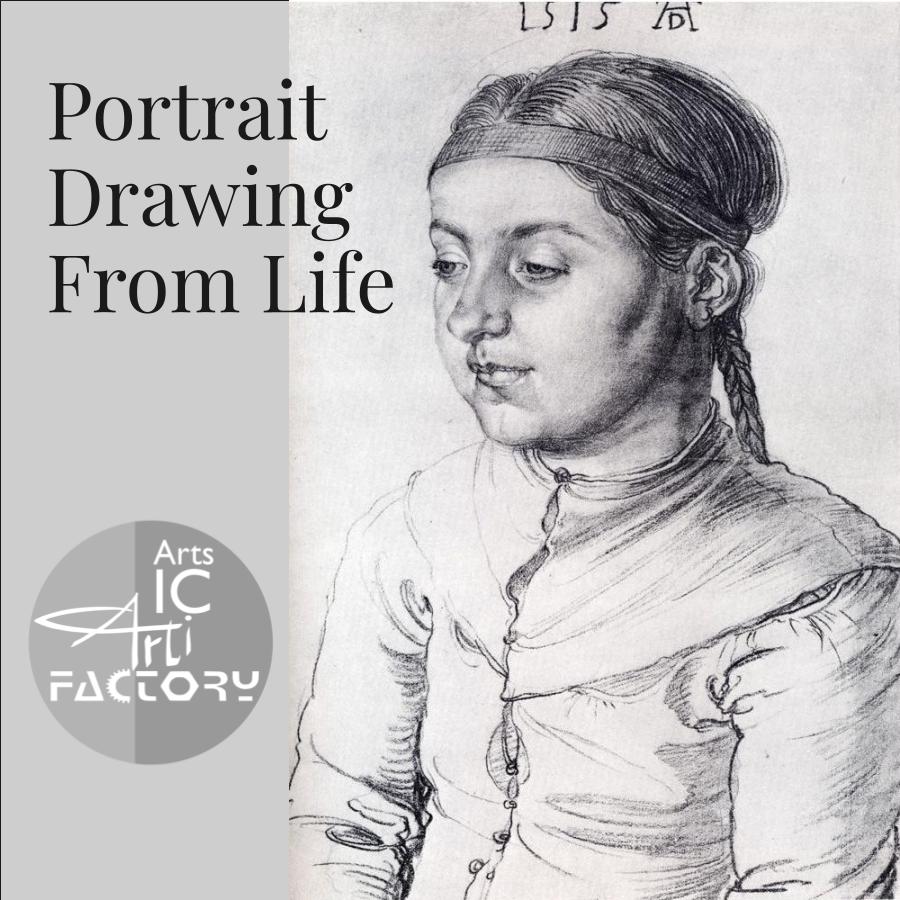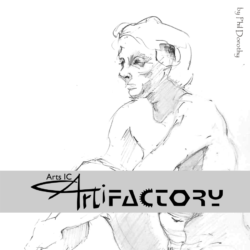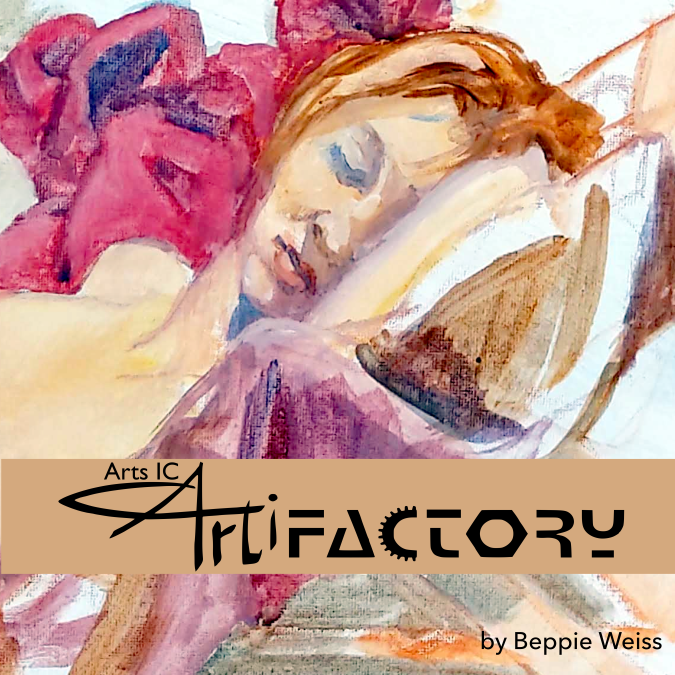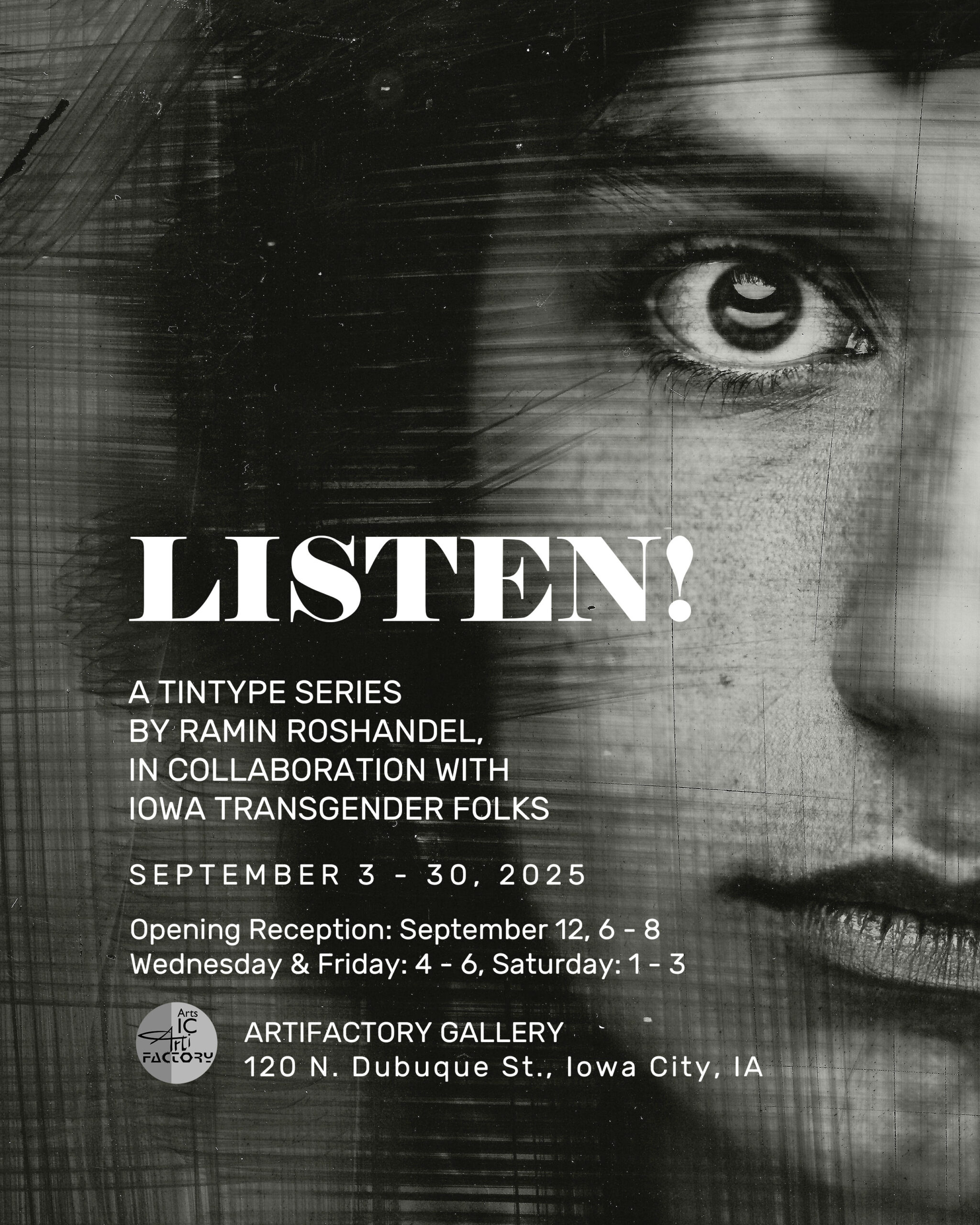Listen! An Art Exhibit by Ramin Roshandel
Join us for a powerful exhibition that demands you to listen. On exhibit September 3-30, 2025. Opening reception September 12 from 6-8 pm.
“Listen!” is a collaborative portrait project by composer and photographer Ramin Roshandel, created to give visibility, presence, and voice to transgender individuals in Iowa. Using the beautiful, 19th-century wet plate collodion process, each portrait is a one-of-a-kind physical photograph on a thin sheet of aluminum—a permanent and archival object in an age of digital transience.
These portraits are not just images; they are a firm and quiet act of resistance. The exhibit emerges in direct response to a February 28, 2025, bill that strips transgender Iowans of state-level protections.
Beyond the striking visuals, “Listen!” features a layered soundscape composed of audio recordings contributed by the participants themselves. Hear their voices, their stories, their poems, and their conversations as they assert their humanity in the face of erasure.
Don’t miss the opportunity to experience this unique blend of sight and sound, a testament to the power of art to create change.
Opening Reception – September 12 | 6-8 pm
On exhibit September 3-30, 2025
Arts IC | ArtiFactory Gallery
120 N. Dubuque St.
Iowa City, IA 52245
Free Admission
Our Gallery is open:
- Wednesdays from 4-6 pm
- Fridays from 4-6 pm
- Saturdays from 1-3 pm
Can’t visit these days? Please make an appointment.

02 Sep 2025 | Portrait Drawing
6:30 PM – 8:30 PM | Stage Area

04 Sep 2025 | Thursday Drawing
6:30 PM – 8:30 PM | Stage Area

06 Sep 2025 | Just The Basics
10:00 AM – Noon | Studio Area

07 Sep 2025 | Long Pose Studio
1:00 PM – 4:00 PM | Stage Area

09 Sep 2025 | Portrait Drawing
6:30 PM – 8:30 PM | Stage Area

12 Sep 2025 | Reception | Ramin Roshandel
6:00 PM – 8:00 PM | Gallery

16 Sep 2025 | Portrait Drawing
6:30 PM – 8:30 PM | Stage Area

18 Sep 2025 | Thursday Drawing
6:30 PM – 8:30 PM | Stage Area

20 Sep 2025 | Body Parts
10:00 AM – Noon | Stage Area

20 Sep 2025 | Junk Journaling
1:00 PM – 3:00 PM | Studio Area

21 Sep 2025 | Long Pose Studio
1:00 PM – 4:00 PM | Stage Area

23 Sep 2025 | Portrait Drawing
6:30 PM – 8:30 PM | Stage Area

30 Sep 2025 | Portrait Drawing
6:30 PM – 8:30 PM | Stage Area
Art Iowa City’s ArtiFactory interview with Ramin Rashondel
ArtiFactory: How did you discover tin-type photography? Why do you think tin-type photography is relevant to the visual arts today?
Although many people in Iowa City know me as a composer, I have been doing portrait photography since 2008, mostly on 35mm film. When, around 2012, I saw a series of wetplate portraits by Mark Sink on the internet, I was hooked by the aesthetics of them, the tone range, and imperfections. It was clear to me then that I had to do it at some point, but I wasn’t able to dedicate myself to the wetplate technique since it requires a long list of gear, time, and, of course, enough budget to kickstart. When I finished my PhD in music composition at the University of Iowa, I told myself I should do it now. I started looking for a large-format camera and found the one that I took photographs of this show with. I started teaching myself the technique using a medium-format camera while I was looking for some small compartments for the one that I had just bought. Eventually, I found those parts and have been taking tintypes ever since.
I think the wetplate technique is relevant to the visual arts today because of its tangibility. As soon as computers emerged (in different forms), digital art was born, and we started to adapt to watching images on screens. This got to the point where everyone has a digital camera in their pocket, aka cellphones. We all have thousands of digital photos on our old and new phones and hard drives, but we barely make physical prints of them nowadays. We even forget sometimes that a lot of those photos still exist on our phones, clouds, or hard drives, and if we want to find a photo that we took five or ten years ago with our digital camera or cell phone, it is probably not an easy task to quickly find it to look at it. Sadly, it seems that photo albums are not a thing either! Tintypes, similar to Polaroids, are direct positives, meaning that one does not need to print them from a negative. This, back in the days, would make them very special, because the moment a photograph was made, one could take their photograph home and frame it. They are also archival, meaning that they last for a long time. There are tintypes that were taken 170 years ago. That is why we see tintypes as family heirlooms and have been passed down for generations.
ArtiFactory: How did you choose your subjects for this show, and why do you think tin-type photography is a good medium for your subject?
I always notice disparities and try to react to them. This exhibition emerges in response to an act that occurred on February 28, 2025, when Iowa Governor Kim Reynolds signed a bill removing gender identity from the Iowa Civil Rights Act. Set to take effect on July 1, the law will strip transgender Iowans of state-level protections against discrimination in housing, employment, public spaces, and beyond. I think tinype, being an archival medium, is a perfect medium because it captures this significant chapter of history in Iowa. Update: On August 19, the Iowa City Council unanimously adopted a resolution, reaffirming its commitment to protecting the LGBTQ+ community’s civil rights. The move comes after Republican state lawmakers this year passed a bill that changed the state’s Civil Rights Act (The Gazette).
ArtiFactory: What drew you to music first in your career and later to photography. Do you see a relationship between music and photography?
I started music when I was a child, but didn’t start photography seriously until I was 20, when I picked up my father’s Pentax K1000. So far, to me, these two have been functioning independently, but at the same time, I don’t see different art media with boundaries, and I always try to see the liminal spaces between them. For instance, this show is technically a “tintype photography show,” but it also has different layers. One is the audio files that correspond to each tintype. There is a QR code below each photograph that the audience can scan and listen to the voice of the person who was photographed. I think this is a very important aspect of this show that makes each photograph very personal. Another layer of the show is a video projection that looks at the subjects of the project from a different angle.
ArtiFactory: Does your work have a message? What feelings and ideas are you trying to inspire in your audience?
I always try to keep the output of my art open, maybe because I am a musician and always like to think of music (and maybe art in general) in an abstract way. To answer your question, though, I think the message could be what the audience would think of after looking at the photographs and listening to the voices.

